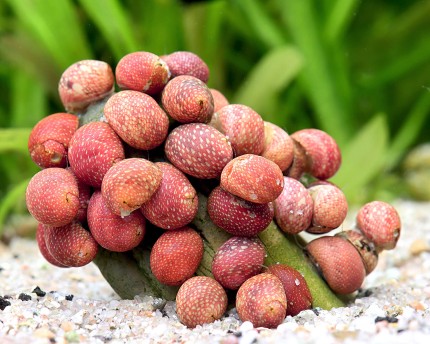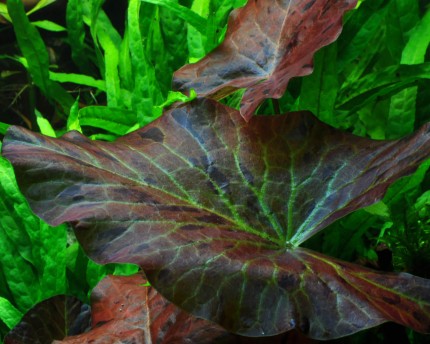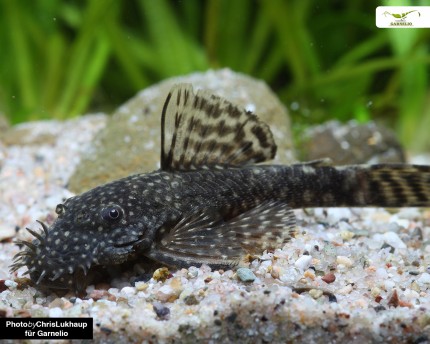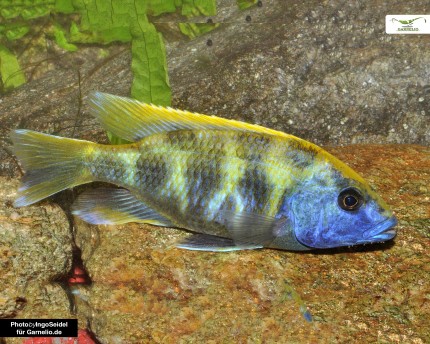incl. VAT plus shipping costs
Immediate delivery, express possible ![]()
Only 10 itemleft in stock
Delivery only innh. Germany and Austria possible.
Switch to the German store
- Item no: 11203
Fast delivery times
All products are in stock with us!14 years of breeding experience
Let our team of experts advise you!High customer satisfaction
from over 3,000 reviews "| Pelvic region: | Center |
| Diet: | carnivore - meat eater |
| Temperature: | 20-25 °C |
| Feature: | Interesting coloring |
| with snails/shells?: | No |
| Fish group: | Cichlids |
| Water values: | Medium hard water |
| Aquarium size: | 250/300 l (approx. 120cm) |
| Planting possible?: | conditional* (see description) |
| Final size: | > 12cm |
| with shrimps?: | Socialization not possible |
| Breeding: | medium |
| Difficulty: | 2 - Normal |
| Origin: | Africa |
| Behavior: | Normal |
| with large crabs?: | No |
| with fish?: | conditional* (see description) |
| Visual effect: | Forms precincts |
| with dwarf crabs?: | No |
| with crabs?: | No |
The colorful check emperor cichlid, also called Aulonocara marmelade cat, is a pretty and colorful representative among cichlids. According to literature, the Auoloncara marmelade cat is a hybrid form, which is not found in nature. Probably it is a crossbreed of Aulonocara and Metriaclima, i.e. a Nonmbuna with a Mbuna, which originally come from the East African Lake Malawi.
The Aulonocara marmelade cat also has the high back typical for perches. The sides are flat and appear pressed together. The forehead falls flat and ends in an underdeveloped mouth with thick lip bulges. The large eyes are conspicuous. The pied emperor cichlid shows variegated colors, so that it can appear orange, but also red or pink, accordingly its fins are colored. Blue spots can be found on its face, as well as blue bands on its body. The long and pointed dorsal fin, as well as the filamentous anal fin, is distinctive to males. Their pectoral fins are also somewhat elongated. At just over 16 centimeters, the Aulonocara marmelade cat grows slightly larger than other Aulonocara species.
In the aquarium, the emperor cichlid check can be bred. Just like other Aulonocaras the Marmalade Cat is a mouthbrooder. Preferably the animals are kept in a harem, but in any case with a surplus of females. To get them in spawning mood, a temperature increase to 27 °C can be beneficial. The female collects her laid eggs with her mouth, where they are also fertilized by the male. After about 21 days the larvae hatch and are cared for by the mother for a while. After free swimming the young can be fed with very small live food like infusoria or slipper fish, but also freshly hatched Artemia or dust food like NatureHolic YoungFeed.
To make these great cichlids feel comfortable, their aquarium should provide at least 300 liters. Light sand is ideal as substrate, with slate and smaller rocks or other hardscape can also build a beautiful reef, which serves the fish as a screen and territorial marking. Care should be taken to ensure that this is secured against falling over so that the fish are not injured when they scurry around in it. In general, the Marmalade cat tends to be a more offensive type than other Aulonocara species as it ages, which can be attributed to its origin. Also caves are accepted, particularly by the females very gladly for resting. With Anubias, whose leaves taste rather bitter, a little vegetation can be introduced into the reef. Regularly the water should be exchanged and replaced, with a flow pump the oxygen content in the water can be increased, which contributes to the well-being of the animals. With a total hardness between 10 and 30 °dGH, as well as a carbonate hardness of 6-30 °dKH they can be maintained well.
Unlike other Aulonocara species, the Aulonocara Marmalade Cat is more aggressive in behavior, especially with increasing age. Therefore the further stocking should be chosen accordingly, keeping in a pure species tank would be recommended. With other Aulonocara species it can also cross, which in turn creates new hybrid forms. Since invertebrates such as dwarf shrimps, snails or mussels are regarded by them rather as intermediate snacks, they should better not be kept together with them .
The Marmalade Cat is a carnivore, which can be supplied in the aquarium however quite simply with commercial dry, - flake or granulated food for Cichliden. They will also eat pellets or sticks. With frozen food or live food its menu can be spiced up from time to time, in general a varied feeding is recommended. Artemia crabs, but also daphnia, tubifex or enchytraea are suitable.
Our food recommendation: NatureHolic Cichfeed is a great staple food for all carnivorous cichlids in the aquarium, perfectly meeting their dietary requirements. The tasty pearls are very well eaten even by larger cichlids. Thanks to their soft texture, NatureHolic Cichfeed food pearls are gentle on the mouth and can be eaten very well by the fish.
Our plant recommendation: Use for planting NatureHolic InVitros. These are free of snails, planarians and other unwanted co-inhabitants. Also free of algae spores, bacteria and fungi.
Expert Tip: We recommend for fish keeping the NatureHolic 3 Phase Liquid. The care set offers the best all-round protection for your animals. It ensures optimal conditions for successful breeding and keeping.
| Scientific name: | Aulonocara marmelade cat |
| German Name: | Emperor cichlid check, Calico emperor cichlid |
| Difficulty level: | advanced |
| Origin/Distribution: | Hybrid |
| Appearance: | variegated colors on pink or red ground color, in males with partial blue markings on face and blue bands. Pointed dorsal fin, filamentous anal fin, up to 16 centimeters |
| Age expectancy | 4 to 6 years |
| Water parameters: | GH 10-30, KH 6-30, pH, temperature 24-27 |
| Tank size: | from 300 liters |
| Food | Carnivores/upstarters, live and frozen food, mosquito larvae, feeder shrimp, artemia, granules, flake food, sticks Natureholic Cichfeed |
| Breeding | medium |
| Behavior | territorial/aggressive towards conspecifics |
| Group size | at least 3 animals: 1 male, 2 females |
| Further information | Ten typical aquarium fish for beginners and alternatives to them, Tips for acclimating fish to the aquarium, Feeding aquarium fish properly - cheap food and what it can do |
- Item no: 11203
Entdecke die Garnelio Welt!
Garnelio gehört zu den größten Onlineshops für wirbellose Aquarientiere weltweit.
Viele Artikel gibt es exklusiv nur bei uns im Shop.











































The fields marked with * are required.
I have taken note of the privacy policy.